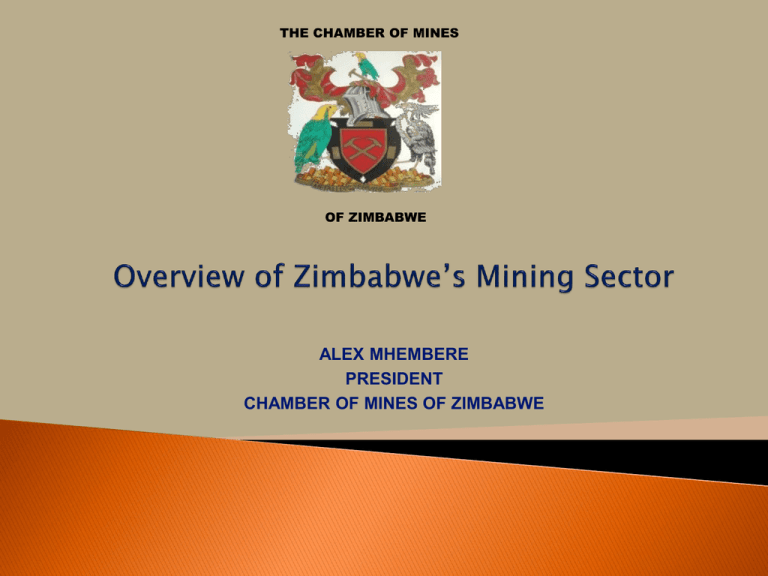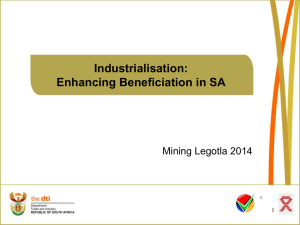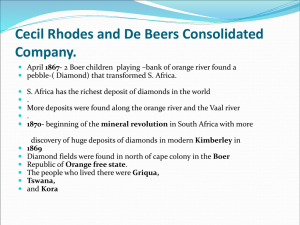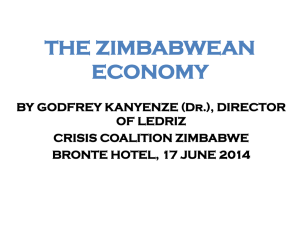Chamber of Mines - Zimbabwe Mining Indaba
advertisement

THE CHAMBER OF MINES OF ZIMBABWE ALEX MHEMBERE PRESIDENT CHAMBER OF MINES OF ZIMBABWE • • Zimbabwe’s mineral resources Contribution of the mining sector to Zimbabwe’s economy: Where have we come from? Where are we now? • • Where to for Zimbabwe? Mining as the cornerstone for economic growth Conclusion THE CHAMBER OF MINES OF ZIMBABWE “The mining sector will be the centrepiece of our economic recovery and growth. It should generate growth spurts across sectors, reignite that economic miracle which must now happen…we need to explore new deposits, developing new greenfield projects in the mining sector. Above all, we need to move purposefully towards beneficiation of our raw minerals.” President R.G. Mugabe inauguration speech 4 • More than 40 different minerals • Diverse mining sector • +800 operating mines • Ranging from artisanal and small scale mines to world class mines 5 THE CHAMBER OF MINES OF ZIMBABWE • The mining sector has to date been the most dynamic sector of the Zimbabwean economy, leading the 2009-2011 rebound with average annualised growth of 35%. Aug 2013 7 Positive correlation between export growth and mineral export growth 5000 4500 Value of mineral exports (1980- 2012) 4000 3500 3000 2500 2000 1500 1000 500 0 1980 1990 1996 2000 2005 2006 mining exports (USD million) 2007 2008 2009 national exports (USD million) 2010 2011 2012 Contribution to Total Mineral Exports 1993-2003 (%) 2004-2011 (%) 2012 (%) Gold 57.3 24.2 26.9% HCF 20 10.7 8.6% Nickel 15.1 11.0 0.7 PGMS* 2.3 46.1 27.2% Diamonds 0.8 6.7 26.1% Others 6.8% 1.3% 10.5% RBZ, MOF, Zimstats 9 Gold Price (USD/oz) USD 2000 1000 Avge Global Price (USD/oz) 0 2003 2004 2005 2006 2007 2008 2009 2010 2011 2012 Zimbabwe Gold Output (kg) 25000.0 20000.0 15000.0 Output (kg) 10000.0 5000.0 0.0 2003 2004 2005 2006 2007 2008 2009 2010 2011 2012 10 Nickel Price (USD/t) 40000 USD 30000 20000 Average 10000 (USD/t) Global Price 0 2003 2004 2005 2006 2007 2008 2009 2010 2011 2012 Zimbabwe Nickel Output (t) 12,000.0 10,000.0 8,000.0 6,000.0 Zimbabwe Output (t) 4,000.0 2,000.0 0.0 2003 2004 2005 2006 2007 2008 2009 2010 2011 2012 11 Coal Price (USD/t) 80 Average Global USD 60 Price (USD/t) 40 20 0 2003 2004 2005 2006 2007 2008 2009 2010 2011 2012 Zimbabwe Coal Output (t) 4,000,000 3,500,000 3,000,000 2,500,000 2,000,000 Zimbabwe Output (t) 1,500,000 1,000,000 500,000 0 2003 2004 2005 2006 2007 2008 2009 2010 2011 2012 12 THE CHAMBER OF MINES OF ZIMBABWE • Mineral output for 2013 expected to surpass 2012 production Mineral Gold (kgs) Coal (tons) Nickel (metric tons) Platinum (kgs) Chrome Ore (tons) Palladium (kgs) Diamonds (tons) 2012 Actual 14,742 2013 Jan-June Actual 6,727.36 1,784,763 955,086.00 2,000,000 7,899 4,887.33 10,000 10,524 6,599.49 12,500 408,475 92,073 282,000 8,136 5,068.54 10,000 12,014,802 2013 Projection - Source: Ministry of Mines, Chamber of Mines 17,000 16,900,000 14 Mining Contribution to GDP (1995-2015) 17.80% 16.90% 15.00% 15.70% 13.00% 12.00% 8.00% 4.30% 1995 3.80% 3.70% 1996 1997 4.00% 3.90% 1998 1999 2009 2010 2011 2012 2013f Aug 2013 2014f 2015f 15 Total Tax Paid Directly by Mining sector to government ($) 445,000,000 387,300,000 167,523,764 57,800,000 2009 2010 2011 2012 Aug 2013 16 70000 59000 60000 51000 50000 45000 39000 40000 38,516 37,971 45,918 45,200 45,800 2010 2011 2012 38,616 33,289 30000 20000 10000 0 1990 1995 2000 2004 2006 2007 2008 2009 Aug 2013 17 • • • • • Contribution of mining companies goes beyond paying taxes Towns and cities have been built around mines (e.g.Bindura, Hwange, Kwekwe and Zvishavane) New local enterprises have been developed through linkages to mining operations Schools and hospitals have been established by mines Sports teams have been established by mining companies (e.g. Hwange FC, FC Platinum) July 2013 18 THE CHAMBER OF MINES OF ZIMBABWE With the new thrust of mining as the cornerstone of economic growth, it’s imperative to: 1. Resuscitate existing mining operations 2. Develop new mines 3. Beneficiate mineral output 4. Establish linkages between the mining sector and other sectors of the economy, particularly manufacturing Resuscitation of Existing Mines 30000 25000 20000 15000 10000 5000 0 1980 1981 1982 1983 1984 1985 1986 1987 1988 1989 1990 1991 1992 1993 1994 1995 1996 1997 1998 1999 2000 2001 2002 2003 2004 2005 2006 2007 2008 2009 2010 2011 Source: COMZ 2012 and RMG 2012 Resuscitation of Existing Mines Resuscitation of Existing Mines Resuscitation of Existing Mines - Capital - Knowledge Feasibility Studies • Exploration & evaluation - Innovation Required for all Stages Refineries • Design, planning & costing Smelter • Drying, smelting Shaft sinking • Converting • Drill, blast, clean, support • Equip Concentrator Development • Mill • Footwall off-reef and onreef • Flotation • Drill, blast, clean, support Stoping Transport • Drill, blast, clean, support • Shaft hoisting • Underground rail transport • Surface rail transport 25 The Chamber of Mines is in full support of the Government’s call for beneficiation of mineral output 1. Down-stream beneficiation - Downstream value addition involves a range of activities including large-scale capital-intensive activities such as smelting and refining as well as labour-intensive activities such as craft jewellery and metal fabrication. • Mining beneficiation – capabilities of the mining company in the areas of smelting or concentration • Manufacturing beneficiation – when manufacturing companies have capabilities to produce a final consumer product 2. Side-stream beneficiation - Refers to inputs, namely capital goods, consumable and services, into the value chain Supported by mining companies in Zimbabwe as well as policy makers To a large extent, mineral beneficiation is already taking place in the country Manufacturing beneficiation took place with the manufacture of asbestos cement products There will be a picture of the mine here Between 1965 and 1978 asbestos was the country's principal mineral in terms of the value of output Production peaked in 1974 at 281kt. 2012 production was 29.5tonnes. Shabanie and Mashaba Mines have been operating below capacity Beneficiation in chromite mining has been taking place through the production of ferrochrome Production: 2012 production was 31.82% down on the previous year at 408,475.81 tons. Most of the smaller smelters remained under care and maintenance during 2012, with ZIMASCO being the only smelting facility operating Mining beneficiation is taking place with the use of coal in power stations There will be a picture of the mine here Most potential in the sector has remained under-utilised Production averaged over 5mt/yr in the 1990s but fell to 1.9mt in 2009 before recovering to 2.8mt in 2010 and 4.6mt in 2011 Hwange Colliery Company continues to be the largest coal producer with additional production coming from Makomo Resources and Galpex. Mining beneficiation for gold mining has been taking place through Fidelity Refiniries Production has rapidly recovered to 14.7tons in 2012 compared to 3.6 tons in 2008 since adoption of the multi-currency system in 2009, production Artisanal and small scale miners play a large role contributing to gold output There will be a picture of the mine here Mining and manufacturing beneficiation used to take place for iron ore mined at Ripple Creek and Steel produced in Redcliff Production peaked in 1992 at 1.46 Mt, and then fell to zero in 2008 Mining beneficiation took place at the Bindura Smelter and Refinery complex There will be a picture of the mine here Bindura Nickel Corporation, the primary producer for nickel placed its smelter and refineries on care and maintanence in 2008 For the past 4 years, most nickel production has been from platinum mining operations as a byproduct. Production: Peaked in 1994 at just over 13,000 tonnes Three operating mines in Zimbabwe; - 2 producing concentrate - 1 producing matte after smelting Potential exists for further beneficiation and work is already in progress in this regard • • It’s critical that linkages with other sectors are created, especially manufacturing Zimbabwe’s manufacturing sector has been hamstrung over the past 15 years, therefore capacity for manufacturing beneficiation is limited 2012 Capacity Utilisation in Zimbabwe Manufacturing 90.0% 80.0% 70.0% 60.0% 50.0% 40.0% 30.0% Level of utlisation 20.0% 10.0% 0.0% Source: CZI State of Manufacturing Survey, July 2013 36 THE CHAMBER OF MINES OF ZIMBABWE Despite constraints, the sector is poised for marked growth in the next 5 years with World Bank (2012) forecasting positive outlook under two scenarios: 1. Base Case ( current policies and costs) • Gross revenues and fiscal revenues of the mining sector to increase by 63 and 87 percent in 2018, respectively, to $4.8 billion and $729 million. 2. Optimistic Case ( assumes investment capital of around $5 billion and optimal policies) • Gross revenues and fiscal revenues of the mining sector to increase by 274 percent and 307 percent in 2018, respectively, compared to 2011. • The increase in gross revenues and fiscal revenues compared to the base case projections for 2018 are 130 percent and 118 percent, respectively THE CHAMBER OF MINES OF ZIMBABWE - Zimbabwe is endowed with abundant mineral resources - indeed mining can become the cornerstone of an economic turnaround - We need to resuscitate existing mines on care and maintenance to pre1998 levels - We need to invest in exploration and new mining development - We need to focus on value addition and beneficiation - We need to focus on linkages To achieve this, we need to address the following issues: - A common national vision - Policy consistency. Mining Policy in progress. To now focus on economic & Industrial Policies. - Competitive fiscal regime - We need to attract investment to the sector - Improve critical infrastructure, i.e. electricity, roads and water supply THE CHAMBER OF MINES OF ZIMBABWE









